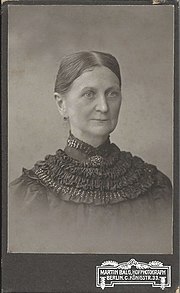Martin Bellow

Photo: Waldemar Titzenthaler , 1909
Erich Gerhard Martin bellows (* 3. October 1864 in Kliczków , Kreis Bunzlau ; † 10. January 1919 in Berlin-Pankow ) was a German court - Photographer in Berlin .
Life
It is not known from whom Balg learned photography, nor how exactly since when he worked in Berlin. In any case, he owned a studio in Berlin in the 1890s (before 1896) on Büschingplatz (postal address Landsberger Straße 100). However, Balg also had a studio in Müncheberg and it seems that this studio was about to start his Berlin career. It appears to have opened in the late 1880s. After Balg had managed to make a name for himself in the small town of Müncheberg (34 km northeast of Frankfurt (Oder) ), he dared to open a studio in Berlin on Büschingplatz in Landsberger Straße (a little west of today's United Nations Square ) to open. The choice of Landsberger Strasse does not seem to be accidental. This address was not central, but in the Königsvorstadt near Stralauer Vorstadt (today Friedrichshain ), several kilometers from the center, but on the arterial road towards Müncheberg. From now on he should have to cope with the 50 km long route to Müncheberg more often, because he ran both studios in parallel. A pub on Landsberger Strasse was also cheaper than in the center. It is noticeable that Balg wanted to keep the entrepreneurial risk as small as possible and that he pursued his goal of becoming as successful as possible in small steps, but continuously.
On April 17, 1896, Balg opened a new studio - at a prestigious location - “on Alexanderplatz ”, as he says on his lapel. The studio was actually in the immediate vicinity of the square and had several postal addresses over time, which made the assignment difficult: At the Stadtbahn 25 (until 1899), Dirksenstraße 25 (1899-1912), Königsstraße 33 (1912-1916) and Königsstraße 34/36 (1916 until after 1932). ( Königstraße is now called Rathausstraße .) When the studio was opened on Alexanderplatz , he initially kept the studio on Landsberger Straße , which, however, had the address Palisadenstraße 106 in the years 1897–1899 . The Müncheberg branch also initially continued to exist.
In 1900 Martin Balg married Agnes Stern, with whom he had their son Erich (1904–1977), who also became a photographer. After Balg had received two medals at exhibitions for the outstanding quality of his photos in 1901, he was given the title of court photographer in 1903, which he probably received from the Principality of Reuss Younger Line . As a successful photographer, Balg also trained photographers. It is known from the life stories of other photographers that the apprentices made an important contribution to the success of the studio of their bosses. Bellow formed u. a. the later Pasewalker photographer Paul Haase .
When Balg died in early 1919 at the age of 54, his widow took over the running of the studio by employing photographers. The son Erich was only 14 at the time and had not yet completed his photography apprenticeship. The continuation of the studio went well, so that in 1926 it was able to celebrate the 30th anniversary of the studio in the same place. The following note appeared on this occasion: “On April 17th, the owner of Hofphotograph Martin Balg in Berlin C 2, Königstr. 34/36, Ms. Agnes Stern, look back on the 30th anniversary of their business. Right from the very beginning, Mr. Balg, the late husband of the owner, was able to turn the atelier on Alexanderplatz, which is well known in Greater Berlin, into one of the most prestigious shops. ”The studio still existed in 1932.
Only studio portraits of Martin Balg are known. So in summary it can be said that he was a very good craftsman, but his photos do not have the same documentary value as those of his colleague Waldemar Titzenthaler . Since no study of its activity has been undertaken to date, this summary sample should be used with caution.
Awards
According to the information printed on his lapel, in 1901 Balg received the "highest award, gold medal at home and abroad", i.e. H. in Hamburg and Naples .
See also
Individual evidence
- ^ Standesamt Berlin X b, Marriage Register No. 513/1900 (Landesarchiv Berlin).
- ↑ registry office Pankow, Death no. 30/1919 (Berlin State Archive).
- ^ A b c Danuta Thiel-Melerski: Photographer Lexicon - Martin Balg .
- ^ Danuta Thiel-Melerski: Photographer Lexicon - Martin Balg
- ^ In the address book of 1929, p. 27, 1895 was erroneously stated as the year of foundation.
- ↑ a b "Nachrichtenblatt für das Photographenhandwerk", 33 (1926), p. 156.
- ^ Sibylle Einholz: Berlin photography studios of the 19th century ...
- ^ Berlin address books.
- ↑ a b "Nachrichtenblatt für das Photographenhandwerk", 39/40 (1932), p. 20.
- ^ Danuta Thiel-Melerski: Photographer Lexicon - Martin Balg
- ↑ Martin Balg in the FotografWiki contrary to the assertion of D. Thiel-Malerski that he would have been a Neussian court photographer, which is apparently based on the confusion of "N" and "R" in curved letters.
- ^ Carsten Plötz: Pasewalk 1848–1945. A century of Vorpommern city history . Berlin: Maass 2005, p. 103.
Web links
- Sibylle Einholz : Berlin photography studios of the 19th century , as a long-term research project of the HTW Berlin - University of Technology and Economics , degree course in museum studies , in cooperation with the Association for the History of Berlin a . A.
| personal data | |
|---|---|
| SURNAME | Bellow, Martin |
| ALTERNATIVE NAMES | Belg, Erich Gerhard Martin (full name) |
| BRIEF DESCRIPTION | German (court) photographer |
| DATE OF BIRTH | October 3, 1864 |
| PLACE OF BIRTH | Klitschdorf , Bunzlau district |
| DATE OF DEATH | January 10, 1919 |
| Place of death | Berlin-Pankow |





